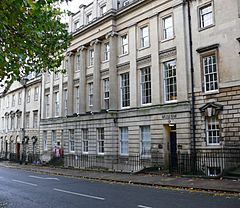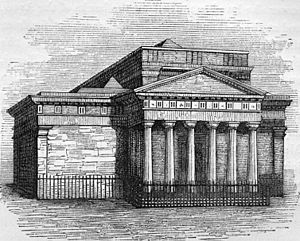Bath Royal Literary and Scientific Institution facts for kids
 |
|
| Founded | 1824 |
|---|---|
| Type | Educational charity |
| Focus | The promotion and advancement of science, literature and art in the city of Bath |
| Location |
|
|
Members
|
approx 500 |
| Website | www.brlsi.org |
The Bath Royal Literary and Scientific Institution (also called BRLSI) is a special charity in Bath, England. It started in 1824. Today, it has a museum, a library, and spaces for exhibitions. It also hosts public talks, group discussions, and displays about science, art, and current events.
Contents
The Start of Science Talks in Bath
In the early 1700s, public talks about science became very popular. This was thanks to famous scientists like Isaac Newton and Edmund Halley. The Royal Society had also been created in 1662.
Bath was a popular city, especially for people interested in chemistry and medicine. They wanted to understand the healing powers of its hot spring waters. The first public science talk in Bath was in 1724. John Theophilus Desaguliers explained a total eclipse of the sun. This talk likely happened at Mr. Harrison's Assembly Rooms. This place was already popular with wealthy visitors. Even though many traveling speakers came to Bath, it took 53 more years for the city's first science group to form.
The Bath and West Society
In 1777, a man named Edmund Rack started Bath's first science and literature group. It was called the Bath and West of England Society. This group focused on improving farming and crafts in the West Country. It was similar to the Royal Society in London.
The society gave out prizes for good ideas. These included better ways to raise animals or new farm tools. One famous member was William Smith. He is known as the 'father of English Geology'. His work with the society helped him understand how rock layers and fossils are connected. In 1974, the society moved its main office from Bath to Shepton Mallet.
Early Science Groups in Bath
The first of three "Philosophical Societies" began in 1779. Edmund Rack was also a key person in this group. Its goal was to be a special group for discussing science and doing experiments. These Bath societies did not last as long as some other groups.
However, they still had important members. One was William Herschel, who discovered the planet Uranus in 1781 while living in Bath. Another was Joseph Priestley. He made important discoveries about different types of air, including oxygen, nearby.
The Bath Royal Literary and Scientific Institution Today
The strongest of Bath's science and literature groups was founded in 1824. This was the Bath Royal Literary and Scientific Institution. Its first home was a grand new building. It was built where the old Assembly Rooms had been, after they were destroyed by fire.
The Duke of York was the first supporter of the Institution. Its first president was the Marquis of Lansdowne. The first person in charge of the museum was William Lonsdale. He was a geologist. His studies of fossils helped other geologists understand the Devonian Period. The word 'Royal' was added to the Institution's name when Queen Victoria continued to support it.
Famous Members of the BRLSI
- Leonard Jenyns (1800–1893) started the Bath Natural History and Antiquarian Field Club in 1855. This club worked with the BRLSI. Jenyns was a close friend of Charles Darwin. He famously turned down the chance to be the naturalist on the voyage of HMS Beagle. Jenyns then suggested the young Charles Darwin for the trip.
- Charles Moore (1815–1881) was a very important geologist. He found amazing fossils in a thin layer of rock near Ilminster. He discovered what he called the 'saurian, fish and insect bed'. He found it after seeing two boys playing with a rock. When the rock broke open, it showed a perfectly preserved fossil fish. Over the years, he collected hundreds of sea fossils from this spot. Many of them still showed soft body parts. In 2010, the BRLSI received a grant to study and protect Moore's fossil collection.
Collections at BRLSI
The institution has an old library with over 7,000 books. This includes special natural history collections. Its archives hold letters from famous scientists like Charles Darwin. There are also smaller collections about religion, government, travel, and local history.
The BRLSI also has four paintings by Andrea Casali. There is also a collection of photographs by Reverend Francis Lockey.
Where the BRLSI Is Now
In 1932, a road project meant the old building had to be torn down. The Institution then moved to 16–18 Queen Square. This building was designed in 1830 and is now a very important historic building.



